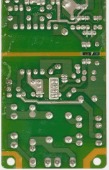The process of using resin to plug holes in PCBs is often necessary due to the presence of BGA components. Traditional BGA designs may require vias between pads and the back layer of the circuit. However, if the BGA is too densely packed, it can restrict via placement. In such cases, it becomes necessary to drill a via directly from the pad to another layer for routing. This via can then be filled with resin, followed by copper plating to create a pad, a technique commonly referred to as the VIP process (via in pad). If vias are created on the pad without filling them with resin, it can lead to solder leakage, resulting in short circuits on the back side and insufficient soldering on the front side.

The PCB resin plugging process consists of drilling, electroplating, plugging, baking, and grinding. Initially, holes are drilled and plated through, followed by resin plugging and baking, with grinding as the final step. Since flat resin lacks copper, an additional copper layer is required to form a PAD. These steps precede the original PCB drilling process, meaning fortress holes are processed first, followed by other holes drilled according to the standard procedure. If the plug hole is not adequately filled and contains bubbles, moisture absorption can occur, potentially causing the board to burst when it passes through the tin furnace. During the plugging process, if bubbles are present and resin is baked, air bubbles may displace the resin, leading to uneven surfaces. Defective products can be identified at this stage, though boards with bubbles do not always burst; moisture is the primary culprit for bursting. Therefore, if a board just shipped from the factory has been baked during loading, it typically won’t lead to bursting.
Coil boards primarily feature winding circuit patterns, with etched circuits replacing traditional copper wire turns, and are mainly utilized in inductive components. They offer numerous advantages, including high measurement precision, excellent linearity, and simple structures. Modular boards—have you heard of modularity and program modules? A modular board is a collection of units designed to perform specific functions. When these modules are individually fabricated into boards, they form a modular board, such as display and power supply boards. For air conditioners, there are AD/DA modules, clock modules, etc., which can be created as small boards and plugged into the main control board. This allows for the same power supply modules to be used across different air conditioner specifications, reducing costs by eliminating the need for redesign. In comparison, coil boards are lightweight, portable, and feature an accessible open coil with a wide frequency range. From the drawings, coil boards distinctly show numerous windings resembling fingerprints.

The PCB resin plugging process consists of drilling, electroplating, plugging, baking, and grinding. Initially, holes are drilled and plated through, followed by resin plugging and baking, with grinding as the final step. Since flat resin lacks copper, an additional copper layer is required to form a PAD. These steps precede the original PCB drilling process, meaning fortress holes are processed first, followed by other holes drilled according to the standard procedure. If the plug hole is not adequately filled and contains bubbles, moisture absorption can occur, potentially causing the board to burst when it passes through the tin furnace. During the plugging process, if bubbles are present and resin is baked, air bubbles may displace the resin, leading to uneven surfaces. Defective products can be identified at this stage, though boards with bubbles do not always burst; moisture is the primary culprit for bursting. Therefore, if a board just shipped from the factory has been baked during loading, it typically won’t lead to bursting.
Coil boards primarily feature winding circuit patterns, with etched circuits replacing traditional copper wire turns, and are mainly utilized in inductive components. They offer numerous advantages, including high measurement precision, excellent linearity, and simple structures. Modular boards—have you heard of modularity and program modules? A modular board is a collection of units designed to perform specific functions. When these modules are individually fabricated into boards, they form a modular board, such as display and power supply boards. For air conditioners, there are AD/DA modules, clock modules, etc., which can be created as small boards and plugged into the main control board. This allows for the same power supply modules to be used across different air conditioner specifications, reducing costs by eliminating the need for redesign. In comparison, coil boards are lightweight, portable, and feature an accessible open coil with a wide frequency range. From the drawings, coil boards distinctly show numerous windings resembling fingerprints.




